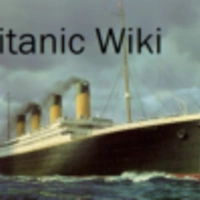
The dream scene, also known as Titanic Heaven, is the last scene of the 1997 film 'Titanic'. Also thought to be Rose's heaven, she is reunited with Jack and his friends, along with the 1503 historical people who died in the sinking.
The scene opens with a shot of the wreck of the real Titanic, panning to the remains of the port-side First Class Promenade on A-Deck. Cue a fade to the non-sunken ship, and the camera pans to the Grand Staircase. The Promade Steward opens the door and the camera enters the Grand Staircase using the Port Vestibule. Over 1500 people greet the person, all of whom died in the sinking. The most prominent ones are Wallace Hartley and the rest of the orchestra, Benjamin Guggenheim and his valet Giglio, John Jacob Astor IV, Isidor and Ida Straus, First Officer Murdoch, Tommy, Fr. Byles, Fabrizio, Helga, Trudy, Capt. Smith, Cora Cartmell and her parents and Thomas Andrews. Jack is up the stairwell, staring at the big clock pointing 2:20. He slowly turns around and stretches out his hand to the person, who is revealed to be a 17-year-old Rose. The two reunite and embrace, sharing a kiss as everyone around them begins to clap. The camera then pans to the sky dome and fades out while the film ends.
Behind the scenes[]
- The first shot was made with actual wreck footage of the Titanic. James Cameron's film was unique in the fact it featured the actual wreck. It remains the only one of the films to feature this.
- Although the scene is supposed to be only with the people who died in the sinking, a small amount of unnamed passengers who survived are also visible in the background, including the Titanic Drunk, Steerage Man 1. One notable person missing is Spicer Lovejoy, likely due to the fact he was the film's secondary antagonist, including sixth officer James Paul Moody.
- Molly Brown was supposed to appear in the sequence but does not as she survived the sinking. Nevertheless, she is implied to be among the crowd.
- The Slovakian father and son did not appear when they died in sinking
- Several details are noted in these sequence:
- Equality in the Afterlife: Passengers of all travel classes on the ship are gathered in one place.
- Frozen clock hands: The clock's hands are frozen at 2:20, the exact time the real Titanic sank. This also alludes to the statement that time does not exist in paradise.
- "The captain goes down with the ship": Captain Edward Smith being the last to applaud references the statement, a maritime tradition that a sea captain holds ultimate responsibility for both their ship and everyone embarked on it and in an emergency will either save those on board or die trying.
- Although often connected to the sinking of RMS Titanic in 1912 and its captain, Edward J. Smith, the tradition precedes Titanic by at least 11 years. In most instances, captains forgo their own rapid departure of a ship in distress and concentrate instead on saving other people. It often results in either the death or belated rescue of the captain as the last person on board.
- Abandoning a ship in distress may be considered a crime that can lead to imprisonment. In the United States, abandoning the ship is not explicitly illegal but the captain could be charged with other crimes, such as manslaughter, which encompass common law precedent passed down through centuries. It is not illegal under international maritime law.
